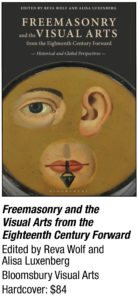 Freemasonry and the Visual Arts from the Eighteenth Century Forward, edited by Reva Wolf and Alisa Luxenberg, details the rise of Freemasonry in the 18th century. During this time period, art played a fundamental role in the Freemasonry practice, rhetoric and global dissemination. This directly influenced the development of art. The book aims to bridge the gap between the subjects and dive into the evolution of the practices.
Freemasonry and the Visual Arts from the Eighteenth Century Forward, edited by Reva Wolf and Alisa Luxenberg, details the rise of Freemasonry in the 18th century. During this time period, art played a fundamental role in the Freemasonry practice, rhetoric and global dissemination. This directly influenced the development of art. The book aims to bridge the gap between the subjects and dive into the evolution of the practices.
The book offers approaches and explores the challenges inherent to the subject by presenting case studies. These studies reveal new dimensions of well-known artists such as Francisco de Goya and John Singleton Copley, and important collectors and entrepreneurs, including Arturo Alfonso Schomburg and Baron Taylor. Individual essays take readers to various countries within Europe and to America, Iran, India and Haiti.
The kinds of art analyzed are wide-ranging porcelain, architecture, posters, prints, photography, painting, sculpture, metalwork and more. They offer a clearer picture of the international scope of the relationships between Freemasonry and art and their significance for the history of modern social life, politics and spiritual practices. In examining this topic broadly yet deeply, the book sets a standard for serious study of the subject and suggests new avenues of investigation in this fascinating emerging field.
Wolf is a professor of art history at the State University of New York in New Paltz, and Luxenberg is a professor of art history in the Lamar Dodd School of Art at the University of Georgia.

